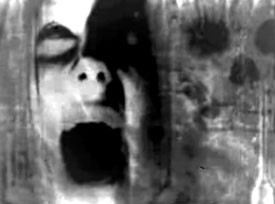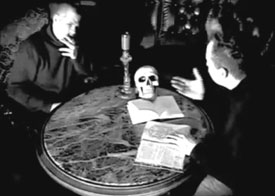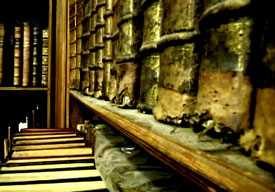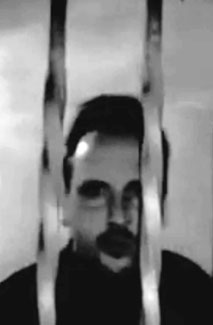 The prolitarianization of cinema is world-wide, thanks to affordable digital cameras, editing software, & free distribution on the internet.
The prolitarianization of cinema is world-wide, thanks to affordable digital cameras, editing software, & free distribution on the internet.
A speck over a quarter-hour, the microfilm La Declaracion de Randolph Carter (The Statement of Randolph Carter, 2007) is by metal-band performer & Lovecraft fan Ignacio Fuentes of Santioago, Chile.
It's in Spanish, apparently a straightforward reading of a translation of the tale, with well-chosen illustrative material in black & white. It rises above the level of a slide show in that the stills are first of all extremely well chosen & arranged, & then altered to look like a single vintage source.
A quick "dashboard translator" automatic translation of the director's discription of his film came out a wacky translation, but seems to he was saying this is his first Lovecraft film. Good job!
 Also a bit over a quarter-hour, Die Aussage des Randolph Carater (The Statement of Randolph Caraer, 2008) is a German interpretation of the Lovecraft yarn.
Also a bit over a quarter-hour, Die Aussage des Randolph Carater (The Statement of Randolph Caraer, 2008) is a German interpretation of the Lovecraft yarn.
Rather sinister carnivalesque music (by the director) generallky fits the tale quite well, & I found to be fine dramatic listening in & of itself.
The film itself is in black & white, sometimes too dark to see anything, but occasionally this seems like the result of a very old silent film's deterioration so is kind of cool. It is a silent film (apart from the musical soundtrack) with intertitle cards, in German.
The occult researches of Harley Warren (Alexander Becker) have brought him to discoveries in old documents that have shocked even him. He solicits the aid of his friend Randolph Carter (Thomas Zymelka) to investigate a crypt that may provide evidence of incorruptible flesh.
Unlike most versions, we see Harley preparing his equipment in advance, the telephone with spool of wire, the shovel, & other gear, before they head off to an antique cemetery. Also for once, they go by day, so that they can see where they're going.
They pry open the lid of a grave, uncovering the secret underground crypt. They rig up the phone so as to remain in communication, & Harley descends into darkness with his kerosene lantern.
Harley as most of us already know will never return, & his horrible fate will be registered on the face of Carter who clutches the phone receiver to his ear. For an added treat, however, we do get to see some of what Harley discovered -- the demonic writing on the walls at least -- & the soundtrack becomes dominated a scratching violin & thrumming viol, truly frightful.
This is one of the finer microcinema adaptations because it does not resort to narrator but is largely a pictorial tale, as cinema must be, & silent cinema the more so. The cinematography is a delightful approximation of the silent era, & the climax is well-sustained.
There's a tiny homage at after the story ends acknowledging some of the classic expressionist filmmakers who inspired musician Sela Bizarr of King Bongo Bongo's Suicide Circus fame.
 A five & a half minute film, Le Temoignage de Randolph Carter (The Statement of Randolph Carter, 2009), possesses a musical soundtrack conveying tragedy, very sharp HD digital videography that has appealing bright color & deep focus, & not at all badly acted by the narrator.
A five & a half minute film, Le Temoignage de Randolph Carter (The Statement of Randolph Carter, 2009), possesses a musical soundtrack conveying tragedy, very sharp HD digital videography that has appealing bright color & deep focus, & not at all badly acted by the narrator.
Young director Jerome Gourdin of Chaumont-Gistoux, Belgium, tells the story quite differently from the original. It's nice to see an interpretive approach among so many extant filmed versions of the specific Lovecraft tale, but unfortunately this one only renders the tale tepid.
Narrated in French without subtitles, the tale opens with an older Randolph Carter (Arnaud Martinez) in a library of very old leather-bound books, speaking with a woman about an incident from his past.
The film goes into a flashback with Harley Warren (Michel Gourdin) & a much younger Randolph (Bruno Bulte), armed with shovel for Randolph, pickaxe for Harley, neither of which will ever be used. They are strolling through a beautiful woodland. The mood is not gloomy, until clouds begin to gather.
This flashback, with continuous narration, the bulk of the tale is told with a series of still photographs as illustration, including some excllent nature phhotography.. The two men come upon a run-down old church, in which Randolph finds himself separated. There is no horrific conclusion, but only a sense of mystery.
The Rolling Stones singing "Paint if Black" is inserted behind the closing credits. The peasant church filmed did have a red door, but this is still a discordant musical choice.
For more H. P. Lovecraft cinema, continue to:
Beyond the Walls of Sleep (2006)
copyright © by Paghat the Ratgirl
|


 Also a bit over a quarter-hour, Die Aussage des Randolph Carater (The Statement of Randolph Caraer, 2008) is a German interpretation of the Lovecraft yarn.
Also a bit over a quarter-hour, Die Aussage des Randolph Carater (The Statement of Randolph Caraer, 2008) is a German interpretation of the Lovecraft yarn. A five & a half minute film, Le Temoignage de Randolph Carter (The Statement of Randolph Carter, 2009), possesses a musical soundtrack conveying tragedy, very sharp HD digital videography that has appealing bright color & deep focus, & not at all badly acted by the narrator.
A five & a half minute film, Le Temoignage de Randolph Carter (The Statement of Randolph Carter, 2009), possesses a musical soundtrack conveying tragedy, very sharp HD digital videography that has appealing bright color & deep focus, & not at all badly acted by the narrator.